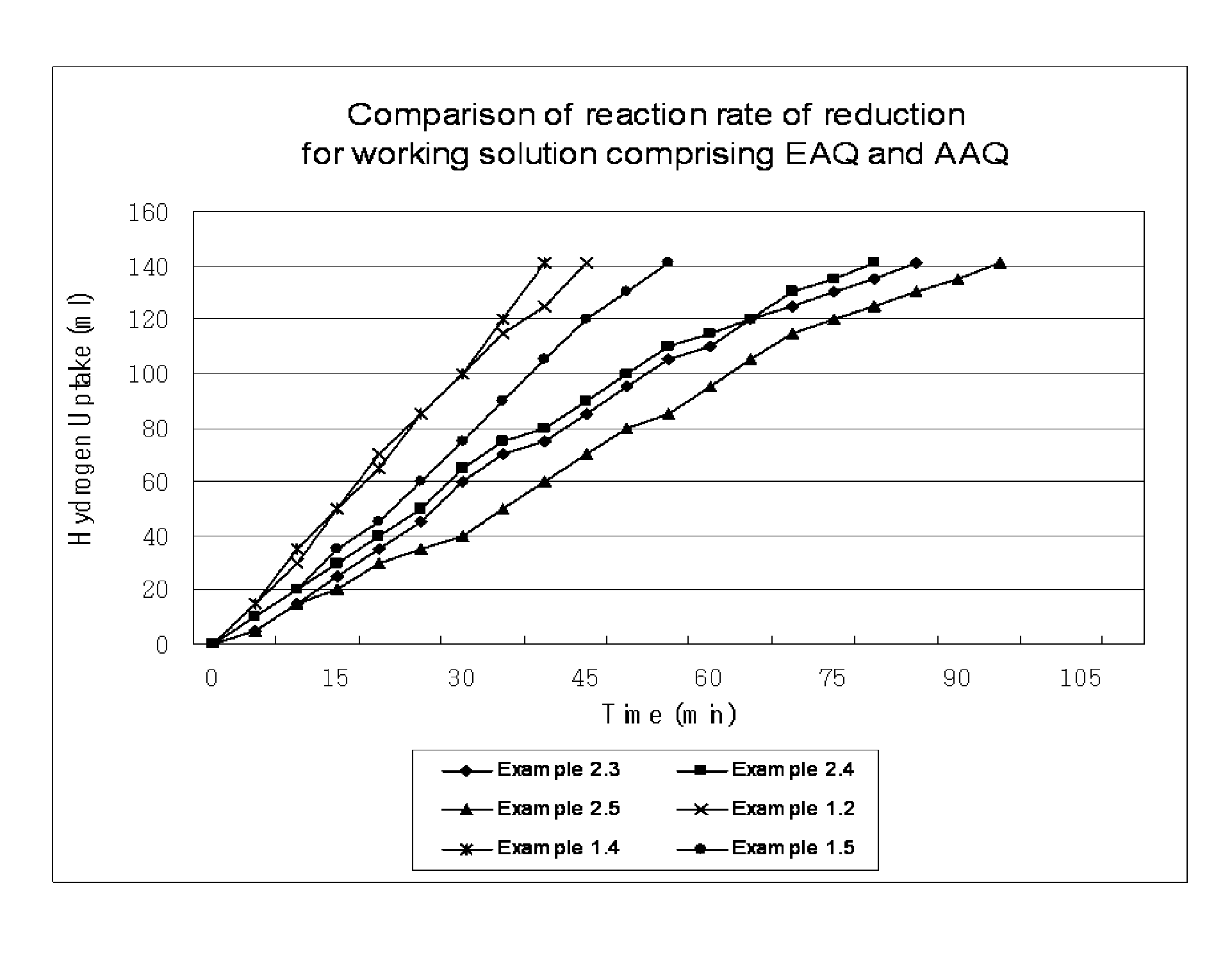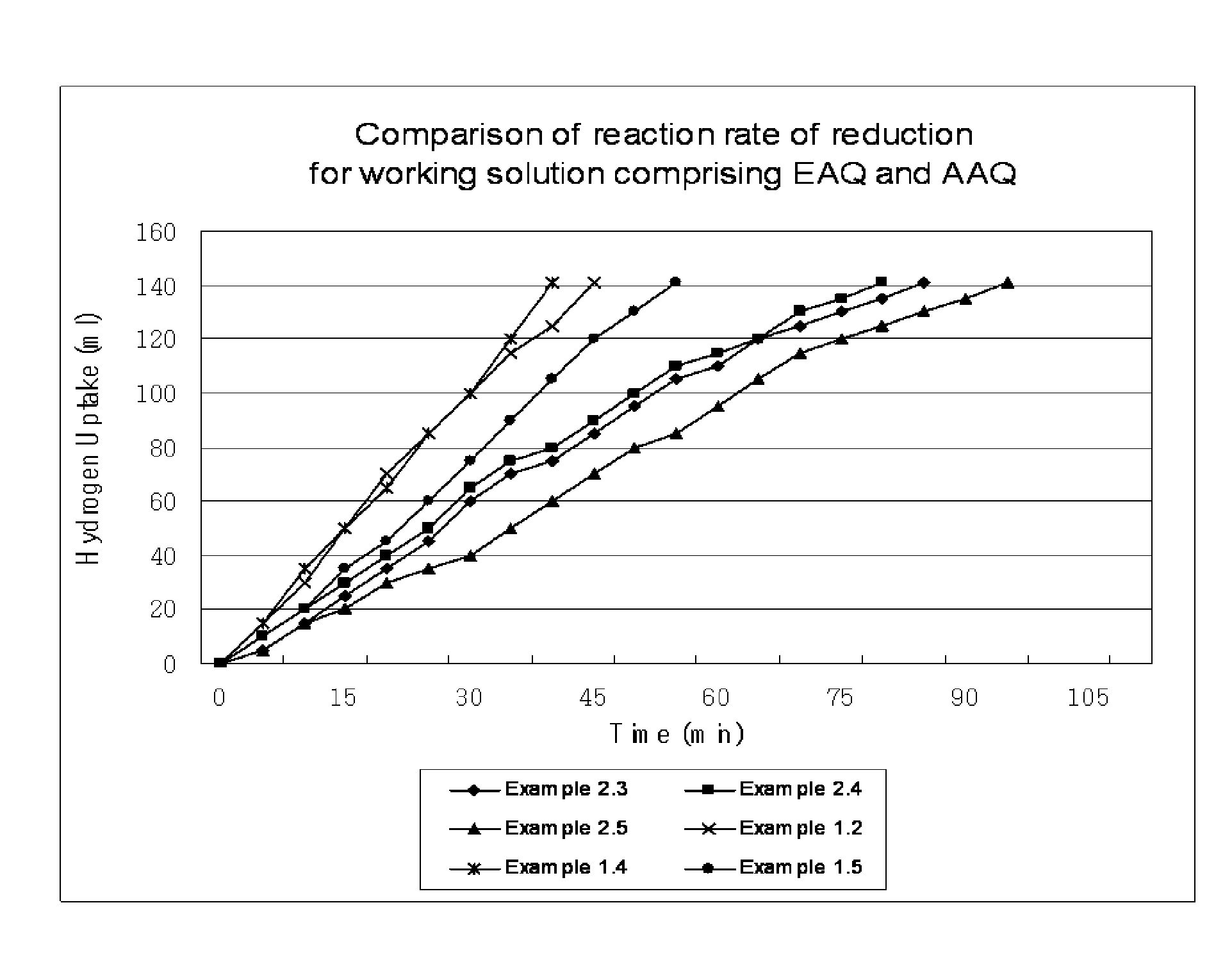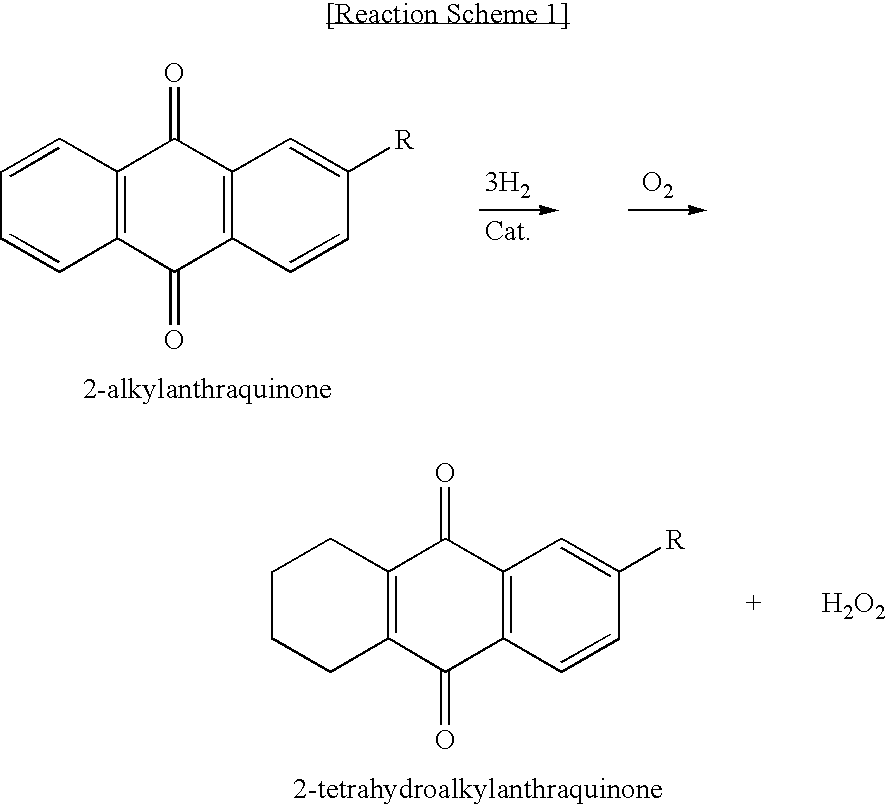Method and composition for preparation of hydrogen peroxide
a hydrogen peroxide and hydrogen peroxide technology, applied in hydrogen peroxide, inorganic chemistry, other chemical processes, etc., can solve the problems of slow hydrogenation reaction rate, loss of alkylanthraquinone through side reactions, and commercially unavailable ihaq, so as to reduce the reduction time, reduce the loss of quinone due to side reactions, and enhance the amount of hydrogen peroxide produced per liter of working solution
- Summary
- Abstract
- Description
- Claims
- Application Information
AI Technical Summary
Benefits of technology
Problems solved by technology
Method used
Image
Examples
example 1
[0050]In a mixture solvent, alkylanthraquinone and tetrahydroalkylanthraquinone are dissolved to a total concentration of 1.26 mol / L, as given in Table 1. As the mixture solvent, a 7:3 (w / w) mixture of alkylbenzene, tetrabuthyurea (solvent A) and a 7:1.5:1.5 (w / w / w) mixture of alkylbenzene, tetrabutylurea and diisobutylcarbinol (solvent B) are used. Alkylbenzene in the mixture solvents (solvent A and solvent B) consists of 16 wt % C9-alkylbenzene and 84 wt % C10-alkylbenzene. After adding the prepared working solution (25 mL), and then 0.3 g of 2% Pd / Al2O3 catalyst to a reactor, the working solution is reacted with hydrogen gas at 45° C. until hydroquinone (HQ) is crystallized. After the reaction, the working solution is separated from the catalyst and HQ crystal, and then a certain amount of the filtered working solution is added to distilled water. After oxidation by reacting with oxygen gas, the concentration of produced hydrogen peroxide is measured to determine HQ solubility.
[0...
example 2
[0058]In order to compare the effect of inert ingredients in the working solution on HQ solubility and reaction rate of reduction, HQ solubility is measured in the same manner as Example 1, except that inert ingredients are not included in the working solution and that the total quinone concentration is set as 0.788 mol / L considering the solubility limit. Quinone composition and solubility measurement result are given in Table 3.
[0059]
TABLE 3Example 22.12.22.32.42.52.6AAQ (mol / L)0.3860.2210.1660.1100.1890.213THAAQ (mol / L)0.1660.3310.3860.4410.4410.496EAQ (mol / L)0.1660.0950.0710.4730.0470.024THEAQ (mol / L)0.0710.1420.1660.1890.1260.055Mol % ratio (amyl:ethyl)70:3070:3070:3070:3080:2090:10Mol % ratio (THAQ:AQ)30:7060:4070:3080:2070:3070:30HQ solubility (mol / L)0.5040.5100.5120.5130.5960.603Hydrogenation uptake (min)1409085809095
[0060]As seen in Table 3, HQ solubility is higher and the reaction rate of reduction is faster when the mol % ratio of amyl:ethyl is 70:30 or higher and when the...
example 3
Stability of Working Solution
[0062]A working solution is prepared by dissolving AAQ (0.143 mol / L), THAAQ (0.366 mol / L), EAQ (0.075 mol / L) and THEAQ (0.140 mol / L) in a 7:3 (w / w) mixture solvent of alkylbenzene (16 wt % of C9 alkylbenzene and 84 wt % of C10 alkylbenzene) and tetrabutylurea. To the resultant working solution, 2.0 wt % catalyst (2.0% Pd / Al2O3) is added in a pressurized reactor, and reaction is performed for 72 hours at 65° C., under a hydrogen gas of 80 psig. The catalyst is removed from the reaction mixture, and the reduced working solution is oxidized to produce hydrogen peroxide. After removing hydrogen peroxide, the composition of the working solution is analyzed by gas chromatography. The result is given in Table 4.
PUM
| Property | Measurement | Unit |
|---|---|---|
| molar ratio | aaaaa | aaaaa |
| molar ratio | aaaaa | aaaaa |
| reaction rate | aaaaa | aaaaa |
Abstract
Description
Claims
Application Information
 Login to View More
Login to View More - R&D
- Intellectual Property
- Life Sciences
- Materials
- Tech Scout
- Unparalleled Data Quality
- Higher Quality Content
- 60% Fewer Hallucinations
Browse by: Latest US Patents, China's latest patents, Technical Efficacy Thesaurus, Application Domain, Technology Topic, Popular Technical Reports.
© 2025 PatSnap. All rights reserved.Legal|Privacy policy|Modern Slavery Act Transparency Statement|Sitemap|About US| Contact US: help@patsnap.com



